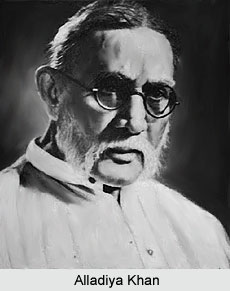 The Jaipur-Atrauli tradition as a Khayal gharana came into existence during the latter part of the 19th century and developed into a full-fledged style during the first half of the 20th century through the arduous efforts of its founder, Ustad Alladiya Khan (1855-1943). His family of singers originally hailed from the village of Atrauli, located near Aligarh. They migrated to a village near Jaipur and attached themselves to the royal court. This gayaki is regarded as one of the most cerebral and scholastic of existing gharanas, given their intricate method of raaga rhythm and the knotty patterning of their musical phrases.
The Jaipur-Atrauli tradition as a Khayal gharana came into existence during the latter part of the 19th century and developed into a full-fledged style during the first half of the 20th century through the arduous efforts of its founder, Ustad Alladiya Khan (1855-1943). His family of singers originally hailed from the village of Atrauli, located near Aligarh. They migrated to a village near Jaipur and attached themselves to the royal court. This gayaki is regarded as one of the most cerebral and scholastic of existing gharanas, given their intricate method of raaga rhythm and the knotty patterning of their musical phrases.
Alladiya Khan`s predecessors were originally dhrupad singers of the Dagar-bani. They took to khayal soon after the popularity of dhrupad began to wane during the later part of the 18th century. His uncle and guru, Jahangir Khan, was reputed to know no less than 25,000 compositions in several ragas. It is reported that Alladiya Khan had a sweet voice until the age of 40. Owing to the severe strain he subjected it to, in order to please his royal patrons of the Jaipur court, he lost it. However, he was able to renovate this setback into an advantage by shifting his mode of voice production and also evolving, through intense practice, a style that gave equal importance to swara and laya. In his later years, he migrated to Kolhapur and trained his brother Haider Khan and his gifted sons, Manji and Bhurji Khan, who carried on his extraordinary legacy. Though he jealously guarded his newly found musical wealth, he slackened his own rules when he came across the outstandingly gifted Kesarbai Kerkar (1892-1977) and Mogubai Kurdikar (1904-2003). They were personally trained by Khansahib and also by his sons. Both Kesarbai and Mogubai went on to circulate his legacy in many parts of the country through the concert platform and also through selective tutelage. Later, Nivruttibua Sarnaik (1912-1994) and Vamanrao Sadoliakr (1907-1991) were included within the charmed circle. The legendary Bhaskarbua Bhakle also learnt from Alladiya Khan. The two masters had the deepest regard for each other. Bhakle`s unexpected and early demise devastated Khansahib to a profound extent. As with the Kirana and the Gwalior style, Maharashtra became the hub of the Jaipur-Atrauli gharana. Some of its finest exponents in the 20th century hail from Maharashtra, the Konkan coast and north Karnataka.
Mallikarjun Mansoor (1910-1992) trained under Khansahib`s son Manji Khan, and later under Bhurji Khan, assimilated many fine points of the style. No blind follower, Mansoor ever maintained his identity all through his singing career by depending upon his immense powers for improvisation. Kishori Amonkar (b.1932), daughter of Mogubai Kurdikar, is one of the stunningly original singers of this gayaki and easily one of the most imaginative women singers in the Hindustani tradition. Though trained in the classic Jaipur idiom by her mother, she ahs not hesitated to take up from other styles. Her music reveals many of the strengths of the Jaipur-Atrauli style and demonstrates none of the limitations. Dhondutai Kulkarni, Ashwini Bhide Deshpande, Padma Talwalkar and Shruti Sadolikar are some of the extraordinary singers on the contemporary scenario.
Some of the distinguishing features of this gharana are
• Prolonged use of open-throated aakaar singing in all three octaves.
• The integrated movement and progression of swara and laya. Complex note patterns are rendered with precision and spontaneity within the framework of a steady medium tempo. The surprising ways, in which they swoop on the sam using all their musical and rhythmical skills, is indeed an eagerly awaited treat.
• Use of elaborate ornaments and complex taans. They spiral and criss-cross against the set framework of the tala in breathtaking manners.
• The song-text and its articulation are only of secondary importance to a number of singers. Note combinations using the words, rather than the literary or semantic content of the song-text, form the focus of their interest. Figuratively put, bandishes are, for the Jaipur singers, pegs on which the raaga swings and sways.
• Unlike other gharanas, they abstain from singing sargams or sargam taans during raaga elaboration.
• Likeness towards intricate, rare and compound ragas, rather than the simple and popular ones.




